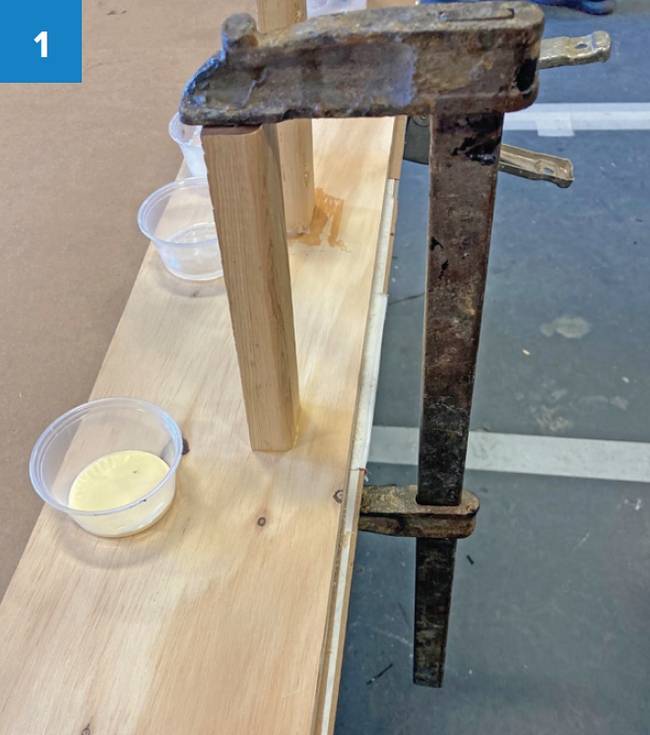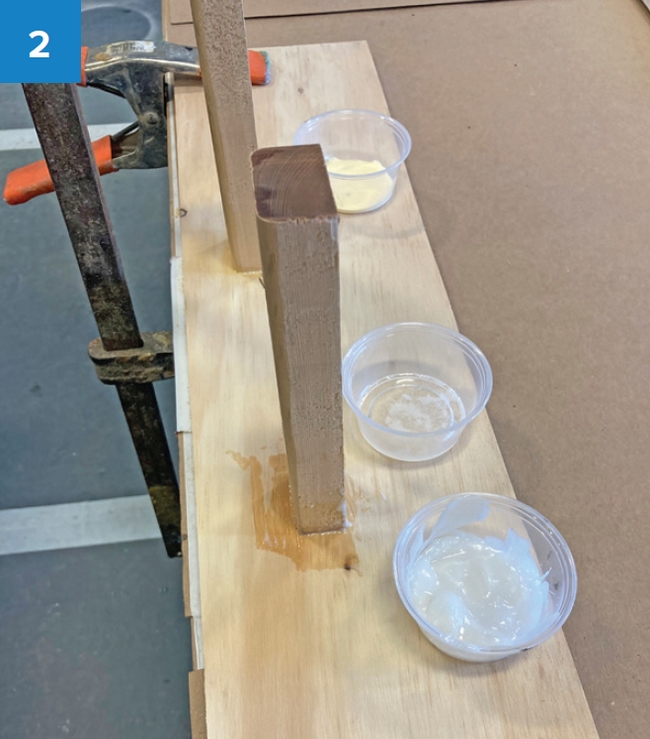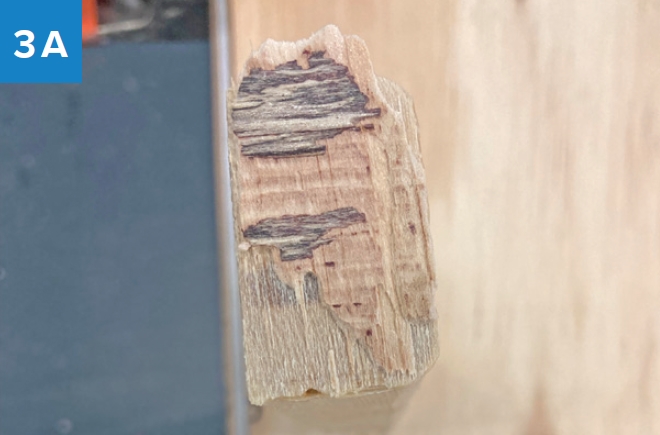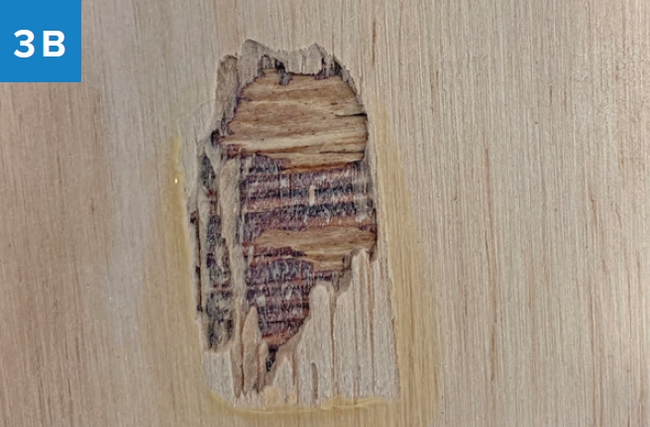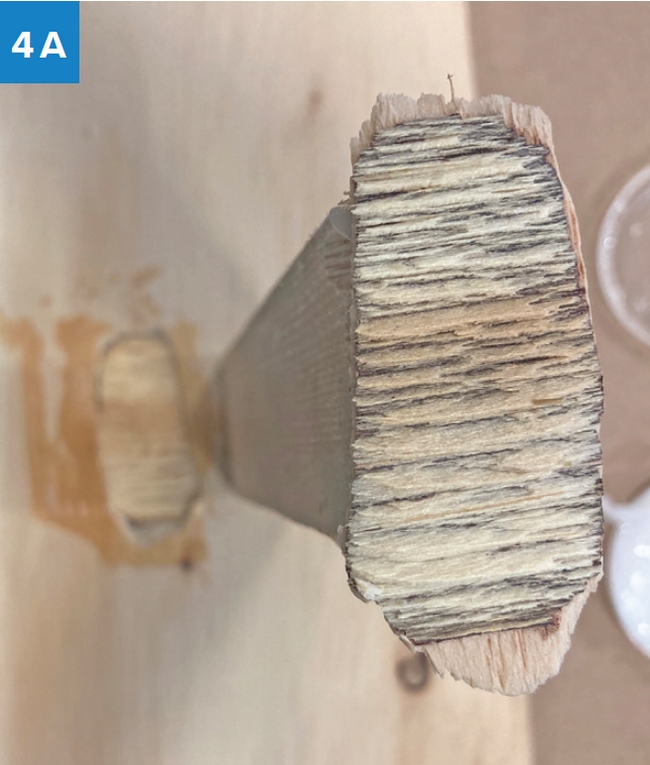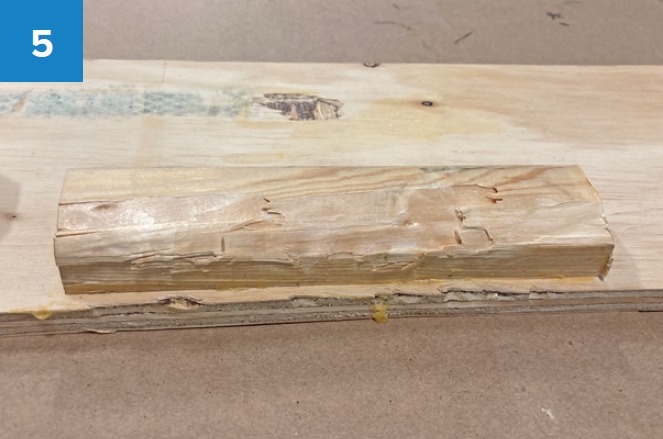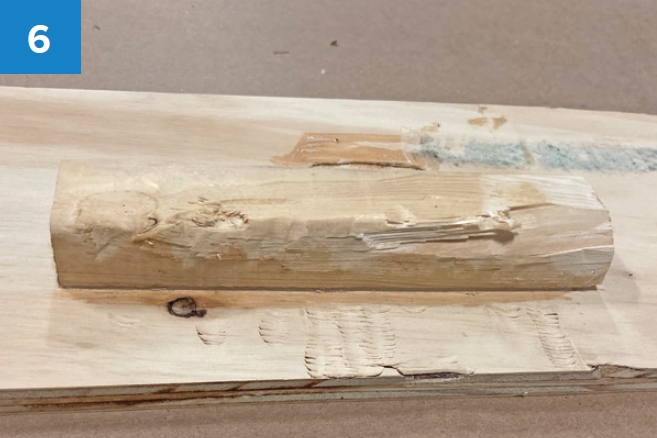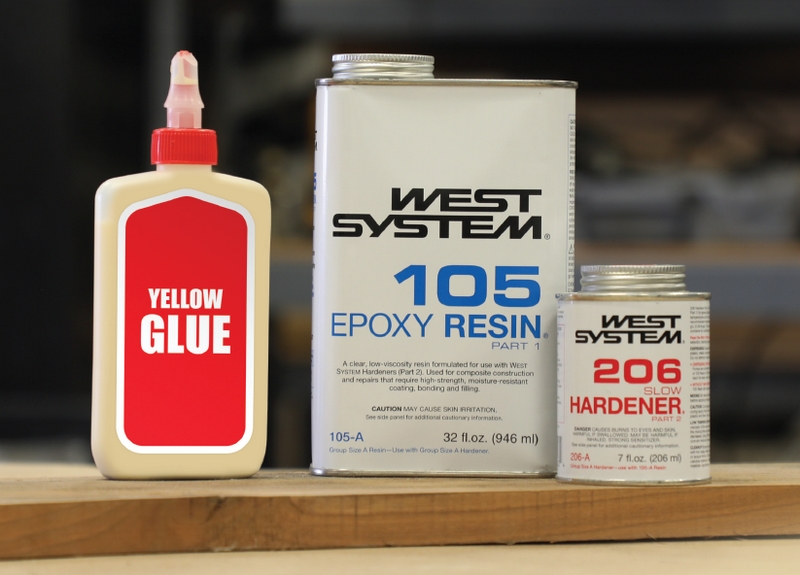
By Rachael Geerts—GBI Composite Materials Engineer
When should you use yellow glue (also called wood glue or carpenter’s glue) and when should you use WEST SYSTEM® Epoxy? This is common question epoxy users ask, especially when trying to choose the best adhesive for their woodworking projects. Let’s look at when one is a better choice than the other, and why.
Cost
Most people notice right off the bat that there is a price gap between the two products. Yellow glues are typically inexpensive while epoxies are more costly. This is a good time to mention that you get what you pay for. Yellow glue is great for many applications but does have its limitations.
Material
This article will only apply to wood applications because yellow glue is inappropriate for work with other materials. When gluing a hem on your dress slacks, you wouldn’t consider using epoxy instead of fabric glue. That being said, the type of wood you are working with could make a difference in which adhesive you may be able to use. Nice dry pieces of mahogany or pine could be bonded with either WEST SYSTEM Epoxy or yellow glue. However, if you are trying to bond oily woods like teak or ipe then WEST SYSTEM Epoxy’s toughness can help you achieve a stronger bond.
Ease of Use
It is important to define each adhesive type. Yellow glue can be identified as an aliphatic resin suspended in water. When the water evaporates it leaves behind intertwined polymer chains that bond the two pieces of wood together. This style of resin is a one-part that allows for easy clean-up with water.
All WEST SYSTEM Epoxies are 2-part systems. When you mix the epoxy resin with the hardener at the proper ratio, the two components react, chemically joining and building the polymer network that adheres the pieces of wood together. While epoxies require measuring and mixing (as opposed to one-part glues), they form a stronger polymer network.
Epoxy can’t be cleaned up with water once it is cured but that’s a good thing. The last thing you want is to put your boat in the water and have the glue joints start dissolving. Since epoxy can’t be easily cleaned up once cured, we recommend making epoxy joints as neat as possible before the epoxy cures. Scraping off excess epoxy from your project with a mixing stick and cleaning your tools with solvent before the epoxy cures can save you a big headache later.
Joinery, Gap Filling Properties, and Shrinkage
The tightness or fit of the joint you want will make a difference in the adhesive you should select. Yellow glue works very well when you have seamless joints and the pieces of wood fit together perfectly. Woodworkers commonly use joinery techniques like biscuit joints, mortise and tenon joints, and tongue and groove joints to increase the bonding area of yellow glue while maintaining very tight and sometimes almost imperceptible joints. Also, yellow glue contains a lot of water that evaporates as the glue dries, so it shrinks quite a bit.
Conversely, WEST SYSTEM Epoxy does not shrink when it cures which makes it great for applications where a perfect fit and/or high clamping pressure is not possible. In fact, epoxy can fail prematurely in very tight-fitting joints or where high clamping pressure creates an epoxy starved joint. We recommend a bond line thickness of approximately 0.01″ (0.25 mm) but epoxy can be used in bond line thicknesses up to ¼” (6.35 mm). It is important to note that in thick applications epoxy can generate a lot of heat, which is called uncontrolled exotherm. Contact our technical department if you have questions about the amount of heat generated in a thick (greater than ¼”) bond line application.
You can improve epoxy’s gap filling properties in adhesive applications by adding one of our four WEST SYSTEM adhesive fillers: 403 Microfibers, 404-High-Density, 405 Filleting Blend, or 406 Colloidal Silica. These fillers increase the epoxy’s viscosity, ensuring continuous contact between bonding surfaces and resulting in a strong bond. Another option is to select a prethickened epoxy like Six10® Thickened Epoxy Adhesive or G/flex® 655 Thickened Epoxy Adhesive.
For best results when joining wood with epoxy and fillers, we recommend two-step bonding. This calls for coating the bonding surface with unthickened epoxy before adding thickened epoxy to fill gaps.
Moisture Content
You should understand the moisture content of the wood you are bonding. What is its moisture content during the bonding application and what is the expected moisture exposure of the finished piece? Since common yellow glue is a polymer suspended in water, the wood you plan to bond should be dry in order for the glue to dry properly.
Many woodworking sites recommend a moisture content between 8 and 12%. This is similar to what we recommend for making structural wood bonds with our 105 System. One of our specialty epoxies, G/Flex 655 Thickened Epoxy Adhesive, excels here as it can achieve a structural bond to wood that has up to 18% moisture content. G/flex 655 can even be used to make temporary repairs on damp or wet wood. Once the wood is glued together, you still need to think about the environment your project will be exposed to. There is a good reason boat builders use WEST SYSTEM Epoxy! It offers excellent moisture resistance once cured. Three to five coats of 105 Resin®-based epoxy can dimensionally stabilize wood by sealing it so the moisture content doesn’t change.
Again, since yellow glue is a polymer suspended in water, it generally won’t hold up well in damp or wet environments.
Strength
Finally, take into account how strong you need the bond to be. As you can see from images 1 and 2, we did a simple test by bonding pieces of end-grain pine to exterior grade plywood, one with yellow glue and the other with WEST SYSTEM Epoxy. After allowing both adhesives to dry/cure for 24 hours, we used a hammer to break the pine away from the plywood. As you can see from images 3 and 4, both adhesives pulled apart the wood fibers in the veneers of the plywood. This type of failure is commonly referred to as failing the wood (since the glue joint hasn’t failed and still has wood on both sides). The epoxy did fail the wood more evenly in the bonding area and through one additional ply of the plywood than the yellow glue. That being said, it was the plywood that failed in both applications, so yellow glue can definitely hold its own.
I wanted to see if I could make the pieces of pine fail so I glued them down again, this time horizontally on the face grain. This increased the bonding surface area. After another 24-hour dry/cure time, I use a sledgehammer. As you can see in images 5 and 6, the bond is still fully intact. You can modify this test to account for the other wood varieties, moisture content, and other conditions previously discussed in this article to see how well each adhesive will hold up in your project.
The Best of Both Worlds
It’s important to note that the only strength described here is adhesive strength. WEST SYSTEM Epoxy has great strength on its own, far above yellow glue’s inherent strength. However, for applications where you are only concerned with adhesive strength and moisture isn’t an issue, either system can work very well. You can also glue pieces of wood together with yellow glue and, once it is fully dried, prep and seal the wood with epoxy. Particularly for non-marine applications or non-oily woods, this approach can offer you the best of both worlds.
There are many aspects of your woodworking project to consider when selecting an adhesive. We’ve highlighted cost, material, ease of use, fit, moisture, and strength of yellow glue and WEST SYSTEM Epoxy. These are important considerations in selecting the appropriate adhesive for your next woodworking project.
